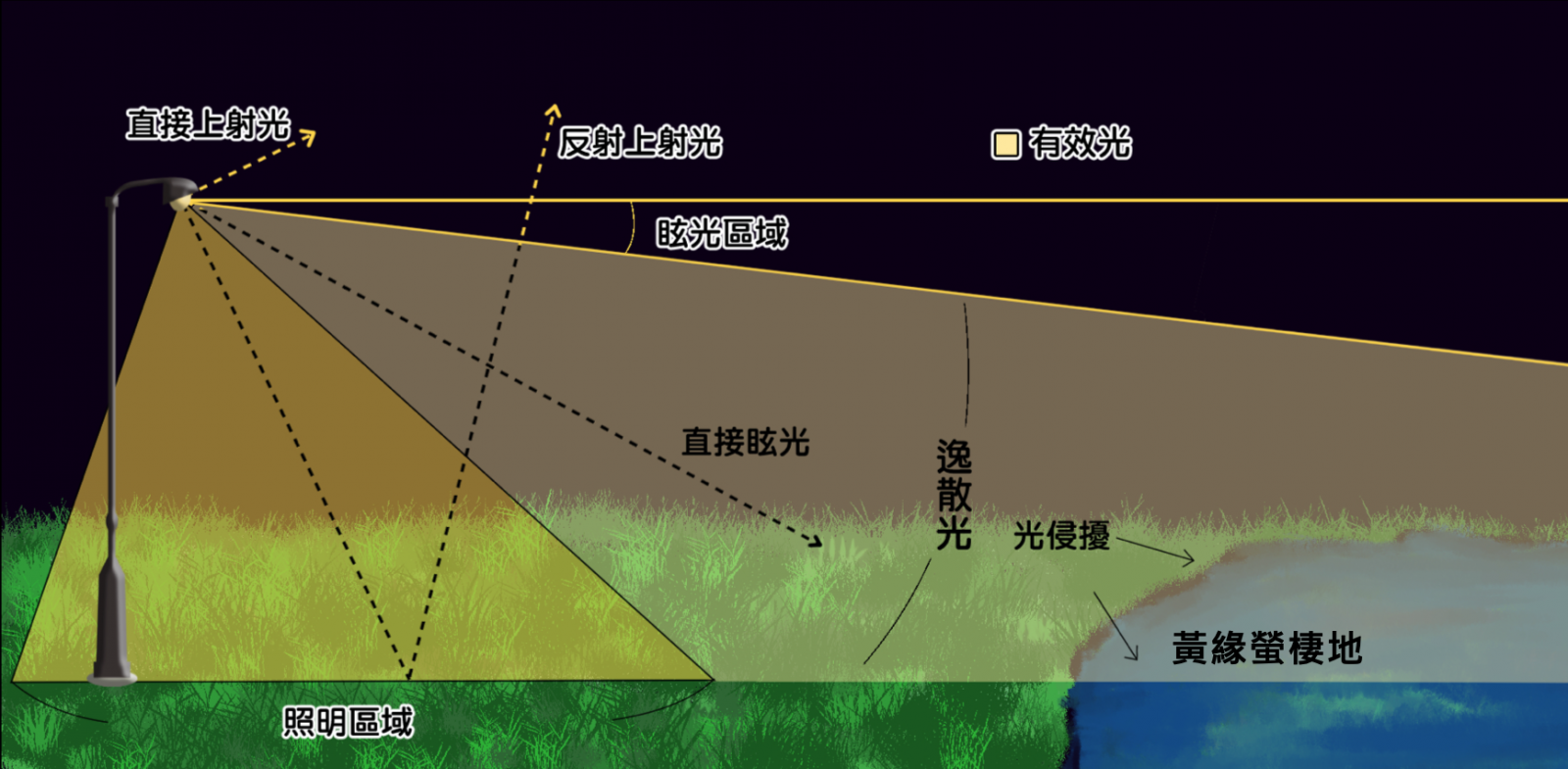揭夜間人工光源恐危害螢火蟲幼蟲基因表現 昆蟲系研究榮登國際期刊
每到春秋兩季,黃昏傍晚時刻,閃閃發亮的螢火蟲就會成為當季「嬌點」,不過近來研究指出,夜間人工光源 (artificial light at night, ALAN) 的溢散恐對螢火蟲造成危害。為檢視ALAN是否對螢火蟲幼蟲也造成影響,台大昆蟲系教授楊恩誠與研究團隊三齡大的黃緣螢 (Aquatica ficta) 幼蟲進行檢測,證實夜間人工光害不止造成螢火蟲行為之改變,更影響螢火蟲幼蟲基因之表現,提高幼蟲死亡率,研究結果榮登《環境污染》期刊 (Environmental Pollution Jounal)。
螢火蟲除了其發光求偶行為是重要的觀光資產外,更是水質和環境健康狀態的指標性物種,螢火蟲族群的維持及延續一直是生態相關研究的重要課題。不過隨著人類活動和環境開發,螢火蟲的棲地受到嚴重的壓縮,加上污染和農藥外流等問題,螢火蟲的數量近數十年銳減。近年來的研究指出,除了以上因素之外,夜間人工光源 (artificial light at night, ALAN) 的溢散造成的夜間光害對螢火蟲的存亡也造成嚴重影響。
夜間人工光源泛指光源本身,或是光源投射到天空或是其他物體,反光後造成的散射光。夜間人工光源會影響生物個體的生理狀態、行為反應、干擾交尾遷移行為,甚至造成個體死亡等,大量個體受到影響進而造成當地生物族群量減少,甚至滅亡。螢火蟲發光求偶的行為會隨著環境光源轉換而調整週期,當環境過亮,螢火蟲的求偶行為則無法進行,此特殊的習性讓螢火蟲族群的存亡嚴重受到夜間光害的衝擊。
除了影響成蟲的求偶行為外,夜間人工光源也會影響幼蟲的活動,研究指出,扁螢屬 (Lamprigera) 螢火蟲的幼蟲夜間進行獵食時,會避開光亮處,如果暴露在光源下則會停止活動。能飛行的螢火蟲在有夜間光源的狀態下可以離開光害區,然而幼蟲或無翅型因活動範圍侷限,如果環境長期有夜間人工光源時,會受到什麼樣的影響則難以評估。
為了檢視夜間人工光源對螢火蟲幼蟲的影響,楊恩誠的研究團隊針對三齡大的黃緣螢 (Aquatica ficta) 幼蟲進行檢測,發現暴露在夜間人工光源兩週後,幼蟲的死亡率較高,並且造成1262個轉錄子的表現受到影響(佔總轉錄子的1.67%,共 75777個轉錄子),受影響的轉錄子功能與激素表現量 (hormone levels) 、蛻皮激素代謝 (ecdysteroid metabolic process)、胰島素受器訊息傳遞 (insulin receptor signaling)、生殖細胞發育 (germ cell development)、卵生成(oogenesis)、精細胞發育 (spermatid development), 以及神經分化之調控 (regulation of neuron differentiation) 等相關。
此結果證實了夜間人工光害不止造成螢火蟲行為之改變,更影響螢火蟲幼蟲基因之表現,進而影響生理反應,造成個體死亡,且這項結論極有可能也會在其他暴露在夜間人工光源之物種上觀察到,夜間人工光源對物種造成的影響需要更謹慎的評估。
此文章發表於《環境污染》期刊(2019 IF=6.793)
研究全文:https://www.sciencedirect.com/science/article/pii/S0269749121005261

楊恩誠研究團隊檢測黃緣螢幼蟲暴露在夜間人工光源下產生的反應。
Effects of artificial light at night (ALAN) on gene expression of Aquatica ficta firefly larvae
During the evening of spring and autumn, the sparkling fireflies are always the highlight of the season. Their fascinating luminous courtship behavior is well-known to the public. Besides, their sensitive environmental nature makes fireflies a useful bioindicator to examine the surrounding ecosystem's health. As a related venerable insect, fireflies' population sustainability has always been an important project for the research topic of related ecological fields. However, the expansion of human activities causes severe habitat shrinkage of fireflies, coupling with pollution problems and the outflow of pesticides. The population of fireflies has significantly reduced. Apart from that, recent studies have suggested that the emission of artificial light at night (ALAN) also negatively impacts fireflies' survival.
ALAN is referred to as the form of local point sources or diffuse skyglow, which can severely affect the physiology (including mortality) and behavior (migration, dispersal, and reproduction) of individuals, consequently harming the population and finally exacerbates accumulated damages to the ecosystem. The firefly courtship is coordinated with the environmental light intensity and interrupted while exposed to ALAN. Moreover, the behavior of firefly larvae can be affected by ALAN as well. The larvae of Lamprigera fireflies, which hunt for snails at night, tend to avoid artificial light sources, while those suddenly exposed to overhead illumination stay immobile. When encountering a stress condition, fireflies with wings can migrate, but larvae or wingless species unable to do long-distance travel must remain under stress.
To investigate the impact of ALAN on firefly larvae development, Professor En-Cheng Yang leads his team to study how ALAN affects the 3rd instar larvae of firefly, Aquatica ficta. The results show that larvae show a high mortality rate after two weeks of ALAN exposure, and a total of 1262 (1.67% out of 75777 unigenes) were differentially expressed. The affected genes are functionally related to hormone levels, ecdysteroid metabolic process, insulin receptor signaling, germ cell development, oogenesis, spermatid development, and regulation of neuron differentiation. Those functions may reflect abnormal physical conditions of firefly larvae after ALAN exposure, suggesting that ALAN impacts the behavior and the gene expression, physical conditions, finally cause the death of A. ficta larvae. This phenomenon may also be happening to other ALAN exposure species. More scientific evidence is required to understand the impact of ALAN on the ecosystem.
More information: https://www.sciencedirect.com/science/article/pii/S0269749121005261
.png)